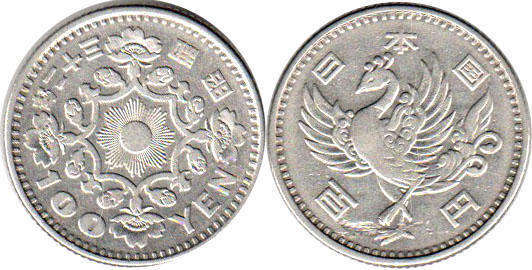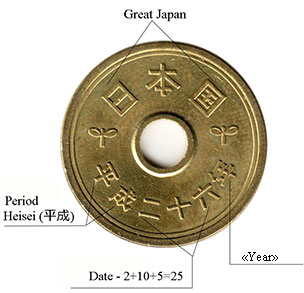Japanese coins identify - how to read
Before the reform of 1870, Japanese coins not dated.
Since 1870, the date is determined by the era (period, epoch) that coincides with the period of the emperor's reign and the year of the era (the number of years from the emperor's reign began). To determine the year of coin issue, the current year of the era should be added to the year of the era's beginning.
Japanese Era
 | 1868-1912 | Era Maidzy, imperator Matzushito | ||
 | 1912-1926 | Era Taisho, imperator Yoshihito | ||
 | 1926-1989 | Era Showa, imperator Hirohito | ||
 | from 1989 | Era Haisay, imperator Akihito |
Japanese numeral system
The numbers in the Japanese system of calculus are formed from digits, just as we have, according to the scheme of discharges. The difference is that in Japanese numbers the bit depth is underlined by an additional digit. For example, the number 48 consists of three Japanese digits - 4, 10, and 8.
Therefore, for the number "100" there is also a special designation, and for example, the number 256 is written as 2-100-5-10-6. But, for the designation of dates on coins, it doesn’t matter - it’s hard to imagine that some emperor could rule for more than 99 years ...
Dating of Japanese coins
How to read inscriptions on Japanese coins
The inscription containing the dating of the coin consists of the following parts:
1. Name of period - two symbols.
2. Year of current period (era) - one, two ore three symbols.
3. Hieroglyph "Year" - one symbol.
For example - 5 yen 2013.
Inscription below from the left to the right:
Heisei period 2 10 5 Year
It's mean - 25 years from beginning of Heisei period (1989) = 2013 (1989+25-1). Not 2014 (1989+25), because 1989 is the first year, not zero.
Attention - on the Japanese coins before 1948 and on the some later coins (for example 100 yen 1957-1958), the date should be read from right to left.

The direction of reading is not specifically indicated, it must be understood logically. For example, on the same 100 yen a year can not be 23, only 32, because first 100 yen coins have been minted in 32 year.



